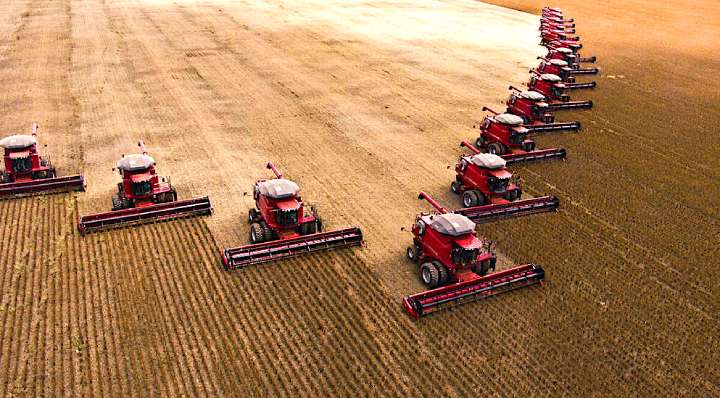 (Source: WWF)
(Source: WWF)
WASHINGTON — It has been six months since Deere & Co. issued its RFP to industry to equip a portion of Deere’s 1.5 million vehicles with satcom connectivity for its farm, forestry and construction customers in the United States and Brazil.
Of this number, 500,000 Deere customers already are connected, almost all of them with cellular.
The bid’s specifications included download and upload speeds of several megabits per second for the high-end machinery. Bidders were asked to have their networks ready for testing late this year, for full commercial availability in late 2024.
Since then, the company has learned a lot about the current and future ecosystem of high-and low-bandwidth satellite-based IoT. Deere’s practice up to now with its cellular-connectivity machinery is to include data plans with the terminals. It’s not clear whether that will be the case for satellite.
However it shakes out, the Deere decision to ensure that every one of its U.S. and Brazilian customers has access to uninterrupted coverage indicates how far satellite IoT has come.
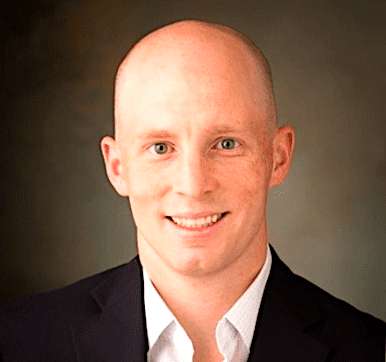 Jonny Spendlove. (Source: Deere)
Jonny Spendlove. (Source: Deere)
Jonny Spendlove, Deere’s senior product manager for connectivity, discussed the status of Deere’s RFP in a March 15 interview here during the Satellite 2023 conference.
How and when did you brief industry on the RFP?
We had our industry day in Iowa and we brought in 60 reps from different companies — operators, terminal manufacturers, etc. Everybody there was on an NDA [non-disclosure agreement] and we basically told them what was going to happen.
What’s the status of the procurement?
We’ve narrowed down the number of proposals that we’re still evaluating. We are testing devices in the field today with some of our RFP participants.
We need to have a product in the market, likely as a kit that will facilitate connectivity on an existing machine population, by the end of 2024.
What means deciding on finalists when?
We expect to have a decision on one or more finalists by the end of the year — that’s our goal — and to have a product coming to market by the end of 2024.
That seems like a stretched-out period — 15 months from RFP to one or more finalists.
Deere is very careful about what we bring to market and the vendors we work with. We try to be very thorough in how we evaluate them. It’s important that we get first-hand testing with terminals and operators in the geographies that are the most important to us, which are Brazil and the United States.
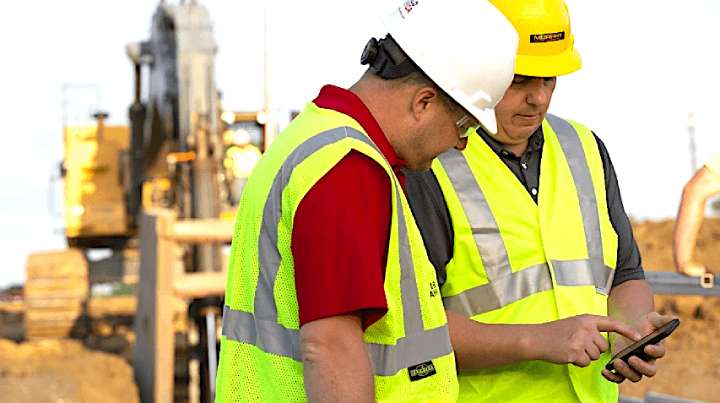 (Source: Deere)
(Source: Deere)
One thing to note is that this for us concerns high-end machines and production systems. We sell our biggest, most valuable machines — combines, sprayers, large tractors — in these two regions. These are also two areas where connectivity is not always perfect. In rural Brazil, you run out of cell coverage the second you leave a city.
70% cell connectivity isn’t enough
You might have a farm that has 50% or 70% connectivity and that needs connectivity throughout the farm.
For in-field data sharing applications, we have customers who have sprayed a portion of their field. Then the wind picks up and they have to leave for the day.
They come back the next day and try to upload the map into the display to show what they have already done as they go back into the field. If they don’t have connectivity in that area, they can’t upload the maps. So they are frustrated. They are driving down the road five miles to get a connection, to load the data, and then drive back.
That’s not a great experience for them or for us. We want to enable and ensure — I won’t say guarantee — our customers a better connected experience so they can use our features in a seamless way and see the value of Deere technology.
The technology also is a good way to economize on pesticides/herbicides and nutrients and water.
Absolutely. While this is about delivering value it is also concerned with enabling customers to do more with less. It’s a sustainability play. If you reduce the amount of overlap you have with your spraying, that’s fewer chemicals in the ground, less fuel that’s being used, better water management. This plays into the sustainability goals of the company.
When you said there were 60 representatives from prospective bidders, that means how many companies who wanted to bid?
Between 25 and 30.
I imagine some said: “I don’t have everything you want right now but this is what I have coming.” That would certainly be the case for some of the IoT constellations.
We had the full gamut. We had folks that partnered with terminal providers that have a solution today. We had folks that said: I am about to release.
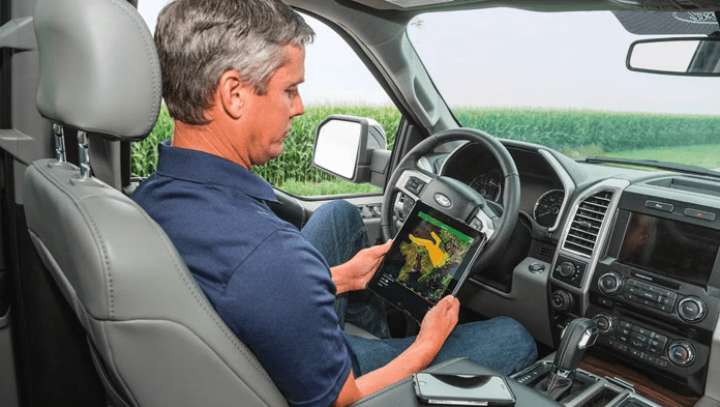 (Source: Deere)
(Source: Deere)
And we had folks who candidly came to us and said: I am not going to participate because I am too far out for you. But let’s continue to have the conversation. Some said: I am very close to being able to deliver this. Here is my proposal and it meets your timeline. Others said they cannot meet the timeline.
And that timeline is what?
We want to be in the market with a solution by the end of 2024. And remember, it takes Deere time to develop a solution once we have tested it with them. We have formal processes as a company to be sure we have clients figured out, legal figured out, and testing of the brackets and other components that will secure this device on a machine. There are other elements of delivering a solution beyond just slapping it on a machine and running it around a field for a few weeks.
We have our quality testing procedure, and it’s very stringent. We are not going to deliver to customers until we have undergone all those processes. And that takes time.
So some satellite IoT startups were eliminated early on because they cannot meet your schedule. How stringent were you in terms of the requirements of the bidders?
We had requirements in the RFP around an ability to meet production timelines and volumes. Those are things we considered as we determined who we wanted to bring forward.
Did you identify satellite architectures you preferred — for example, saying that latency was a big deal for 20% of your users so there has to be a LEO component?
No, we didn’t start with that. We had some ideas but we did not rule anybody out based on GEO or LEO. Our feeling was that our needs could be met by GEO constellations.
A combined LEO-GEO offer would be nice, but GEO-only is acceptable
We said: Give us your best proposal. From a redundancy and future-proofing perspective, we did have a preference for a combined GEO-LEO solution. We thought that having both constellations available would be a good thing. But we didn’t rule anybody out because of that.
There are some companies that could offer something like that LEO-GEO combination, but perhaps not quite yet.
With some LEO constellations still being built out, we understand that this is part of the future even if it might not necessarily be available. But for any that are not going to be there within our dates, we said: Thanks for coming.
Your goal is to connect 1.5 million Deere machines?
The 1.5 million is an enterprise goal for connectivity. Not all of these are going to be satellite connectivity. We want to be able to help customers use the data that the machine is creating for their benefit, whether it’s in landscaping, or utility vehicles, or sprayers or combines or tractors or construction equipment. It’s a subset of that 1.5 million that is going to be satellite-enabled.
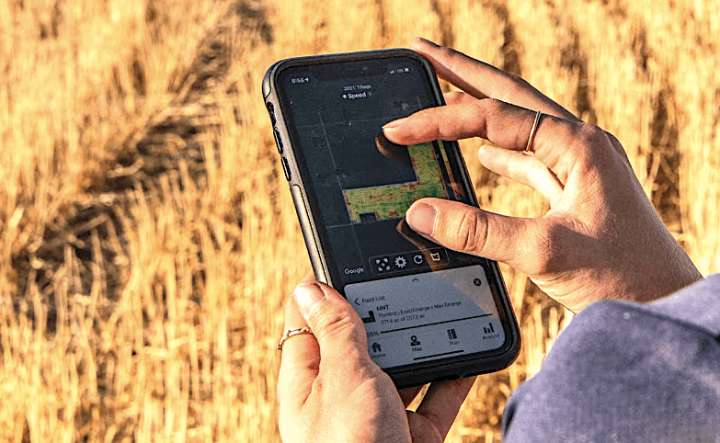 (Source: Deere)
(Source: Deere)
Most of the 500,000 machines that are currently connected are production and precision agriculture, or construction and forestry. There is a large existing machine population of production and precision-agriculture machines that I think are good candidates for satellite connectivity, for a kit to go on those machines.
They are connected today with cellular. Some them can connect most of the area where they work, but other machines have a modem that has not been connected for some time because it’s not near a cell tower. That is outside of the 500,000 and it’s possible that that satcom terminals could be useful to that group.
We have customer in Brazil, for example, that equipped all their machines when it was an option, with cellular modems, and didn’t realize it was not gong to work on their farm. When you get a satcom module on there, you bring those into the connectivity network.
Do you assume that the amount of territory that is not covered by cell networks will gradually reduce over time?
We have baked in assumptions for growing cellular coverage. But in Brazil, the assumption is that it’s going to be much less the case. We think there is still going to be a huge gap in cellular connectivity in 10 years in Brazil. You look at the number of cell towers you would need to cover areas not connected today and it’s just huge.
There will still be plenty of gaps in coverage. It’s just too big a space. We have customers with farms of over 1.5 million acres — 100 miles in any direction.
Our tech stack is important enough to our customers and our dealers and ourselves that we want to enable it where we can, as soon as we can.
Of the 500,000 Deere machines currently equipped, what portion is satellite?
Today, it’s effectively zero. We have a very small subset that uses a satellite module, mainly in forestry equipment.
For the cellular service, is that a Deere expenditure or do customers manage their own data plans?
Today Deere covers it, on our modems. We pay for all of the cellular data. So when a precision agriculture machine leaves the factory and goes to a customer, as well as the combines, sprayers, large tractors — the top end stuff and increasingly we will introduce it on the lower-end stuff — we cover the cellular charges.
Reducing or eliminating that friction makes the operator better, makes the dealer better, makes our engineers better at their jobs. They can use data and optimize their performance. It leads to better operators in the field, better fleet managers and better dealers because they have a better view of the problems customers are facing.
So we do all that today.
Will you continue to cover the data plans as you add satcom?
I am not saying that going forward, on satcom, we will necessarily cover all that. We are still figuring out the business model there. But if you look at what we’ve done in the past, we would like to reduce friction as much as possible. The value of our tech stack to our customers, to Deere, to the dealers — is big enough that deploying it is very important with satellite connectivity.
So when you negotiate with the vendors on data plans, you’re negotiating on behalf of yourself? I imagine you can you can negotiate volume discounts.
We are a pretty attractive customer. I mean, we are going to pay our bills. You’re going to get a lot of business if you work with us.
Should I assume that latency isn’t a big issue if you’re willing to accept an all-GEO offer?
With GEO the latency is, say, 500 milliseconds, so a one-second round trip. Our operations center map, the digital ecosystem map, updates every five seconds. So if I am at the center of a farm and I want to see what’s happening in real time, today I get an update every five seconds.
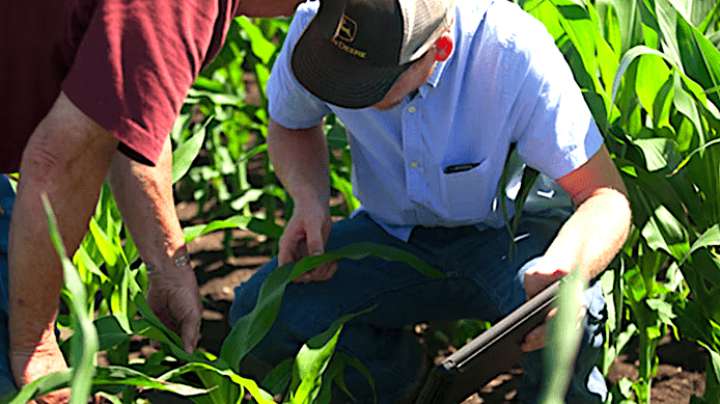 (Source: Deere)
(Source: Deere)
So if latency is many seconds, that’s a problem. For our current use cases 50 milliseconds [for LEO] vs 500 milliseconds is not a deal breaker.
That may change in a few years.
Exactly, which is why we have talked about having a LEO and a GEO, to future-proof our system, as well as for redundancy. But we are also talking about taking customers who are not connected in any way today, all the way to connectivity. We don’t want to let the perfect get in the way of the good.
You are willing to sign multi-year contracts with the satellite providers?
I don’t know that we’ve gotten to that point. We are certainly having conversations. We would probably look to what we’ve done in other parts of our business. This is a big first step for us into the high-bandwidth, big data pipeline. We want to make sure we are simultaneously securing a good business model for ourselves and also providing flexibility. I don’t know that we have got that nailed down enough.
Do you encourage vendors to team with others to make a more complete offer to you?
I think in some cases that’s necessary and it was something that we encouraged, where needed. We were open to that.
Even if that means you have two parties, instead of one, to deal with over the contract’s life.
Yes.
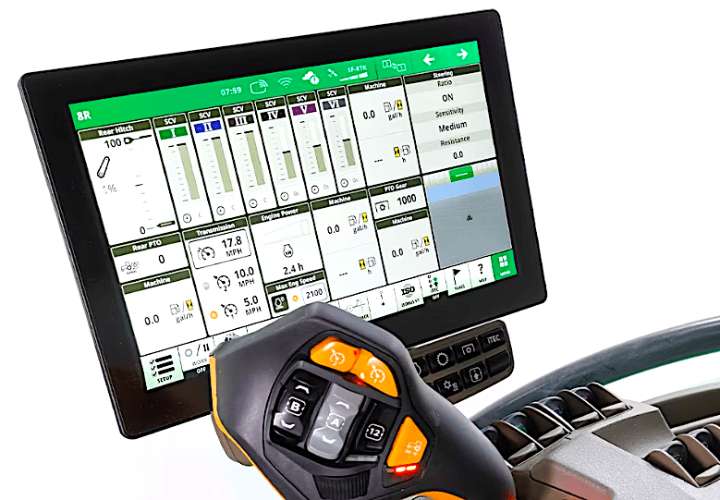 (Source: Deere)
(Source: Deere)
On the technical specifications, what is the high end and low end of the bandwidth requirement?
We needed something in the megabits per second, up and down. So when you talk kilobits per second IoT, this is way beyond that.
But as you spread this over 1.5 million machines you will have some users in the kbps level?
Yes, we’re going to use cellular on a bunch of them. If there are areas where cellular connectivity is poor, we can introduce satcom. Most of our solutions fit within single-digit megabits per second.
What use case needs megabits per second on a regular basis?
In-field data sharing, autonomy, software downloads, remote access into a display, or transferring files to a machine. If I have to transmit information about what I have seen in the field, you are talking videos and those are megabits.
For the 500,000 connected machines now, mainly cellular, do you work with just a few network operators?
We have one primary one MNO in some countries and in some places we were with MVNOs [mobile virtual network operators] who buy data from the MNOs. We work with them to do the regulatory needs around the world or to deal with service gaps.
It’s our SIM in the box. So in some countries, they don’t let you roam for more than 90 days with a global carrier, so we work with an MVNO who works with the local carriers and we get data that way. We might not be able to work with the operator you work with in a certain country, but we certainly can work with the MVNOs.
On the technical standards among satcom terminals: Your contract might not be big enough, but a couple of large customers have imposed standards on its suppliers. Maybe Deere could not do this on its own, but stitch together a couple of Deere equivalents…
I feel like we are maybe a bit early in that to be playing that game. It’s something that’s interesting to me because it feels like something that would make it easier to connect machines. We are interested in that conversation.
Read more from Space Intel Report.
